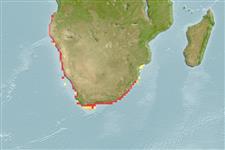Common names from other countries
Environment: milieu / climate zone / depth range / distribution range
Ökologie
seewasser riff-verbunden; tiefenbereich 10 - ? m (Ref. 5213). Subtropical; 12°S - 36°S, 10°E - 34°E
Southeast Atlantic to southwestern Indian Ocean: southern Angola to Natal, South Africa.
Length at first maturity / Size / Gewicht / Alter
Maturity: Lm 34.0 range ? - ? cm
Max length : 80.0 cm TL Männchen/unbestimmt; (Ref. 4370); max. veröff. Gewicht: 6.5 kg (Ref. 4370)
Rückenflossenstacheln (insgesamt): 10; Rückenflossenweichstrahlen (insgesamt): 18-19; Afterflossenstacheln 3; Afterflossenweichstrahlen: 13 - 14. Changes from black to silver almost instantly to blend with environment; occasionally mottled or with 7-9 crossbars (Ref. 4370).
Found in inshore reefs, rocky and sandy areas. Feeds on mollusks, crustaceans, and other invertebrates (Ref. 5213). Abundant in winter, breeding occurs in deeper water. Becoming scarce because of overfishing (Ref. 36731).
Smith, M.M., 1986. Coracinidae. p. 601-602. In M.M. Smith and P.C. Heemstra (eds.) Smiths' sea fishes. Springer-Verlag, Berlin. (Ref. 4370)
IUCN Rote Liste Status (Ref. 130435)
CITES (Ref. 128078)
Not Evaluated
Bedrohung für Menschen
Harmless
Nutzung durch Menschen
Fischereien: kommerziell; Sportfisch: ja
Mehr Information
ReferenzenAquakulturAquakultur ProfilZuchtlinienGenetikElectrophoresesVererbbarkeitKrankheitenVerarbeitungMass conversion
PartnerBilderStamps, Coins Misc.LauteCiguateraGeschwindigkeitSchwimmstilKiemenoberflächeOtolithsGehirngrößeSehfähigkeit
Tools
Zusatzinformationen
Download XML
Internet Quellen
Estimates based on models
Preferred temperature (Ref.
115969): 14.4 - 24.7, mean 16.7 (based on 20 cells).
Phylogenetic diversity index (Ref.
82804): PD
50 = 1.0000 [Uniqueness, from 0.5 = low to 2.0 = high].
Bayesian length-weight: a=0.01622 (0.00664 - 0.03964), b=3.01 (2.79 - 3.23), in cm Total Length, based on LWR estimates for this species & (Sub)family-body (Ref.
93245).
Trophic level (Ref.
69278): 3.3 ±0.45 se; based on food items.
Widerstandsfähigkeit (Ref.
120179): niedrig, Verdopplung der Population dauert 4,5 - 14 Jahre. (K=0.13).
Fishing Vulnerability (Ref.
59153): High vulnerability (60 of 100).
